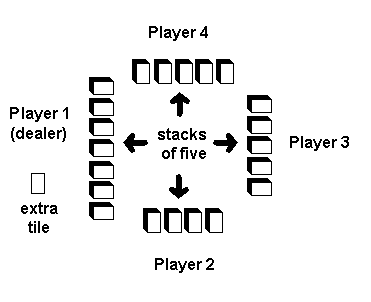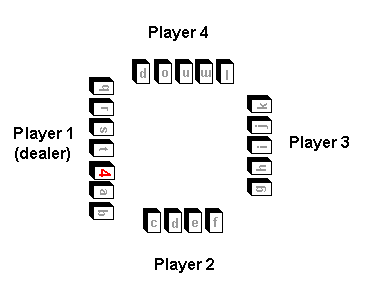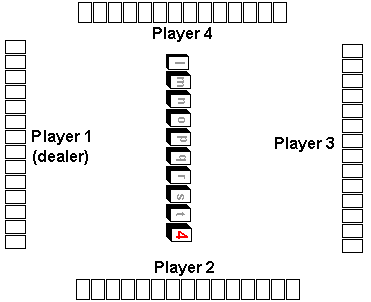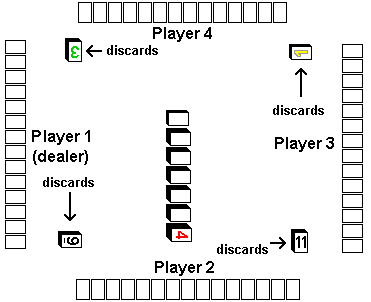Okey
This page is based mostly on information from Turgay Unalan.
- Introduction - Equipment, Players and Objective
- Distribution of Tiles and Determination of Joker
- Play
- Scoring
- Variations
- Other Okey WWW sites, software and online games
Introduction - Equipment and Players
Okey is a popular Turkish game of the Rummy family, played with a set of 106 wooden tiles. The faces of the tiles are numbered from 1 to 13, with the numbers printed in various colours. There are eight tiles of each number: two red, two yellow, two green and two black. In addition there are two special tiles without numbers - these are known in this game as "false jokers" (in Turkish "sahte okey"). The backs of the tiles are plain, so tiles that are face down on the table or held by another player all look the same.
One 6-sided die is used during the distribution of tiles.
Okey is almost always played by four players, although it is possible for two or three people to play.
The whole game is played anticlockwise.
During the game each player has a hand of 14 tiles. The object is, by drawing and discarding tiles, to be the first to form a hand that consists entirely of sets of equal numbered tiles, and runs of consecutive tiles of the same colour.
Distribution of Tiles and Determination of Joker
The first dealer is chosen at random. After the hands have been played and scored, the turn to deal passes to the right.
The 106 tiles are placed face down on the table and thoroughly mixed. Then the players set them up into 21 stacks of five tiles, the tiles in each pile being face down. One tile is left over - this is temporarily kept by the dealer. The stacks are lined up in front of the players, something like this:

There is no specific rule about how many stacks should be in front of each player. It is convenient to have at least six in front of the dealer, but this makes no real difference to the game.
The dealer now throws the die twice. The result of the first throw selects one of the tile stacks in front of the dealer, counting from left to right. The dealer places the single remaining tile on top of this selected stack. If the number thrown is greater than the number of stacks in front of the dealer, then the count will continue using the stacks in front of the player to dealer's right, and one of these will be selected. The selected stack now has six tiles.
The second throw of the die selects one of the tiles in the selected stack, counting upwards from the bottom of the stack. The selected tile is extracted from the stack and placed face up on top of it. If the selected tile is a false joker, it is returned to the selected stack and the second throw of the die is repeated until a numbered tile is selected.
This face up tile determines the "joker" (okey) for the game - a wild tile that can be used to represent other tiles to complete a combination. The joker is the tile of the same colour and one number greater than the face up tile. For example if the face up tile is the green 10, the green 11's are jokers. The false jokers are not wild - they are used only to represent the tiles that have become jokers. So for example when the green 11s are jokers, the false jokers are played as green 11s (and cannot represent any other tile). If the face up tile is a 13, the 1's of the same colour are jokers.
Now the stacks of tiles are distributed to the players. The player to dealer's right will receive 15 tiles and the others 14 each. The player to the right of the dealer takes the next stack after (to the right of) the selected stack with the face up tile on top of it, then the player opposite the dealer takes the following stack, and so on anticlockwise around the table, until each player has two stacks (10 tiles). Now the player to the dealer's right receives the whole of the next stack, but the player sitting opposite the dealer is given only the top 4 tiles of the following stack. The player to the dealer's left receives the last tile of this stack and 3 tiles from the top of the next stack, and finally the dealer takes the last 2 tiles from this stack and 2 from the next stack.

In the above diagram the dealer threw a 5, placed the spare tile on to of the 5th stack from her left. She then threw a 2, and took the second tile from the bottom of the selected stack and placed it on top. It is a red 4, so red 5's will be jokers for this deal. Now player 2 must take stack 'a', player 3 stack 'b', player 4 'c', player 1 'd', player 2 'e', player 3 'f', player 4 'g', player 1 'h' and player 2 'i'. Next player 3 takes the top 4 tiles of stack 'j', player 4 the last tile of 'j' and three from 'k', and player 1 two from 'k' and two from 'l'.
All the players should arrange their tiles so that they can see their faces but the other players cannot. Wooden racks are often used for this. The remaining tiles are left for the players to draw from during the game. They are moved to the middle of the table, without looking at them or disturbing their order.

Play
Before the play begins, if any player holds the tile that matches the face up tile on top of the last stack of six tiles, the player may show that tile, and score one point.
Now the player to the dealer's right begins the play by discarding one tile, face up. After this, each player in turn may either take the tile just discarded by the previous player, or draw the next tile from the supply in the centre of the table, and must then discard one unwanted tile. This continues in anticlockwise rotation until a player forms a winning hand and exposes it, ending the play.
Discarded tiles are placed to the right of the player who discarded them, in a stack, so that only the most recent discard in the stack is visible.

The usual rule is that you are allowed to look through all the tiles in the discard stacks to your right (the tiles you discarded) and to your left (the tiles you had an opportunity to take), but you can only see the exposed top tiles of the two discard stacks on the other side of the table.
The object of the game is to collect sets and runs.
- A set consists of three tiles (üçlü) or four tiles (dörtlü) of the same number and different colours. (So for example a black 7 plus two red 7's would not form a valid set.)
- A run (el) consists of three or more consecutive tiles of the same colour. The 1 can be used as the lowest tile, below the 2, or as the highest tile, above the 13, but not both at once. So green 1-2-3 or yellow 12-13-1 would be valid runs, but black 13-1-2 would not be valid.
A winning hand consists of 14 tiles formed entirely into sets and runs - for example two sets of 3 and two runs of 4, or a run of 6 plus a run of 3 plus a set of 4. No tile can be used as part of more than one combination (set or run) at the same time.
Another type of winning hand consists seven pairs. Each pair must consist of two identical tiles (for example two black 9's). Two tiles of the same number and different colours do not make a pair - the colours must be the same as well.
If you have a winning hand, then you can end the play by exposing all 14 of your tiles after discarding. Apart from the discards and the face up tile on top of the six-tile stack, no tiles are exposed until a player shows a winning hand: no sets or runs are exposed during the game.
Tiles are always drawn from the top of the next available stack. When only the final stack of 6 tiles remains, the exposed tile is removed from the top of this stack and the other five tiles are drawn in order. The exposed tile (the red 4 in the example diagrams) can never be drawn. When there are no tiles left in the centre except the single exposed tile, if the next player to play does not want to take the previous player's discard, the play ends because there are no cards left to draw.
As already explained, the two tiles that are the same colour as the face up tile and one greater in number are the jokers. These tiles can be used to represent any tile the holder desires, in order to complete a set or run. For example, if the red 4 is face up, the red 5's are jokers. {Green 6, red 5, red 5, green 9} would count as a run, using jokers for the green 7 and 8. Alternatively, {yellow 10, black 10, red 5} would be a set, using the red 5 to represent the red or green 10.
When collecting a hand of seven pairs, a joker can be used with any tile to form a pair.
The two false jokers - the tiles without numbers - are used only to represent the joker tiles. So for example when red 5's are jokers, the false jokers are played as red 5's: for example {red 4, false joker, red 6} is a run, and {black 5, green 5, yellow 5, false joker} is a set.
[New players may wonder what is the purpose of using a different tile as the joker for each game. It would seem to be logically equivalent to use the false jokers as jokers and every tile to be what it appears to be. A possible reason may be that if through any defect in the tiles, some players learn to recognise the false jokers from the back, that would give them an unfair advantage. If a different tile is used as the joker in each game, recognising a joker from the back becomes much more difficult.]
If you have a winning hand of groups and runs using at least one joker, you do not have to expose it immediately. If you wish, you can continue playing in the hope of forming a winning hand plus a joker. If you are able to end the game by discarding a joker and exposing your remaining 14 tiles as a winning hand, your win is worth twice as much as an ordinary win. Note that by continuing to play instead of exposing your ordinary win, you run the risk that another player may complete a winning hand and expose it before you can achieve your double win, in which case you gain nothing for your concealed winning hand.
Scoring
Each player begins the game with 20 points and loses points each time another player wins a game, as follows:
- When a player wins an ordinary game, each of the other players loses 2 points.
- When a player wins by discarding a joker, each other player loses 4 points.
- When a player wins with seven pairs, each other player loses 4 points.
Also, if at the start of the play, a player shows the tile that matches the face up tile on the six-tile stack, each of the other players loses 1 point. This is known as gösterme (to show), and can only be claimed before the holder of the matching tile first draws a tile.
If the game ends without any player exposing a winning hand (because there are no tiles left to draw, and the player whose turn it is cannot win by taking the previous discard), then there is no score.
Play continues until any player's score reaches zero or less. The two players with the highest scores at that time are the winners and the two with the lowest scores are the losers.
Variations
Some play that any player whose score reaches zero or less leaves the game, but the other players continue to play.
Some play that the players sitting opposite each other are partners. In practice partners cannot help each other much, except by cheating(!) [In the partnership game, presumably each team starts with 20 points, and when a player exposes a winning hand, the opposing team loses 2 or 4 points as appropriate. If a player shows the tile matching the exposed tile at the start, the other team loses 1 point.]
Some players use the exposed tile as the last tile to be drawn from the centre, when all the other tiles have been taken.
Some players omit the formal procedure for choosing the joker and distributing the tiles. Having shuffled the tiles face down on the table, each player simply takes any 14 tiles from the table (the player chosen to play first taking 15) and a tile is turned up to be the joker. When drawing tiles during the play, any face down tile can be taken from the stock on the table.
Some play that a player who wins a game with tiles of one colour only, the score is doubled: the other players lose 4 pints if the winner discarded an ordinary tile, 8 points if the winner's final discard was a joker. Some only award this double score for a hand consisting entirely of red tiles or black tiles.
Okey 101 is described on a spearate page. The players take 21 tiles each (22 for the dealer) and tiles can be melded during play. A player's first meld must be worth at least 101 points.
Other Okey WWW sites and software and online games
Antonin Jaun's site rummy.ch (archive copy) had rules for Okey in German.
OkeyOnline is a multiplayer online Okey game for the iPhone.
Okey Extra for Android is available from Digitoy Games
The Game Cabinet has published a page of Rules of Okey by Enric Capo. However, the description there is not of the Turkish game Okey, but of a game similar to the Sabra version of Rummikub®, which is played with essentially the same equipment.